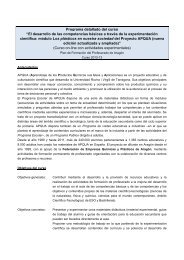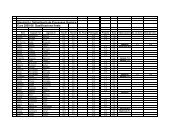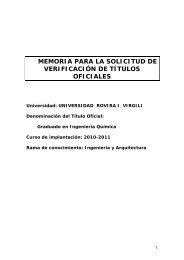A Transferable Force Field To Predict Phase Equilibria and Surface ...
A Transferable Force Field To Predict Phase Equilibria and Surface ...
A Transferable Force Field To Predict Phase Equilibria and Surface ...
You also want an ePaper? Increase the reach of your titles
YUMPU automatically turns print PDFs into web optimized ePapers that Google loves.
The Journal of Physical Chemistry B ARTICLE<br />
Lx A+ΔA = Lx A (1 + ξ) 1/2 , Ly A+ΔA = Ly A (1 + ξ) 1/2 , <strong>and</strong> Lz A+ΔA = Lz A /<br />
(1 + ξ) where ξ f 0. The area (A + ΔA) of the perturbed state<br />
thus equals Lx A Ly A (1 + ξ), <strong>and</strong> ΔA is equal to Lx A Ly A ξ. These<br />
transformations conserve the volume of the box in the perturbed<br />
state. In this method, several simulations should in principle be<br />
repeated for different ξ values to correctly extrapolate the surface<br />
tension for ξ approaching zero. However, as recommended by<br />
Biscay et al. 34,35 we have performed one simulation with a ξ parameter<br />
equals to 5 10 4 since it has been shown to give correct<br />
surface tension. The operational expression for the calculation of<br />
γ within the TA method is:<br />
γ TA ¼ ∂F<br />
∂A N, V, T<br />
¼ ∑ k<br />
lim<br />
ξ f 0<br />
ðUðA þ ΔAÞðzk, r0NÞ UðAÞðzk, rN * ! +<br />
ÞÞ<br />
kBT<br />
k, A<br />
ð17Þ<br />
kBT<br />
ln exp<br />
ΔA<br />
Æ...æk,A indicates that the average is carried out over the reference<br />
state <strong>and</strong> the k slabs. U (A+ΔA) (zk,r 0N ) <strong>and</strong> U (A) (zk,r N )are<br />
the configurational energies of the slab k in the perturbed <strong>and</strong><br />
reference state.<br />
Tail corrections to the surface tension have also been accounted<br />
for using the expressions given by Biscay et al. 36 More<br />
detailed descriptions of these models <strong>and</strong> long-range corrections<br />
to be applied can be found elsewhere 31,37 42 <strong>and</strong> will be not<br />
discussed in this work. Note that both methods have been<br />
successfully applied with the AUA4 force field to calculate surface<br />
tensions of various hydrocarbons. 34,43<br />
The initial configuration of the system was prepared from<br />
equilibrated bulk liquid <strong>and</strong> bulk vapor phases, the bulk liquid<br />
phase (containing 750 molecules) being surrounded by two bulk<br />
vapor phases (containing each of them 10 molecules) along the<br />
z-axis. The Lx <strong>and</strong> Ly dimensions of the resulting simulation box<br />
are fixed to 30 Å, <strong>and</strong> the Lz dimension varies from 260 to 420 Å<br />
according to the temperature. The Ewald sum technique is used<br />
to calculate electrostatic energy, with a number of reciprocal<br />
vectors equal to 8 along the x- <strong>and</strong> y-axis <strong>and</strong> equal to (8L z)/L x<br />
along the z-axis. The Monte Carlo moves <strong>and</strong> their attempt<br />
probabilities used during the simulations are: translation<br />
(33.5%), rigid rotation (33.5%), <strong>and</strong> configurational-bias regrowth<br />
(33%). A typical simulation consists of an equilibration<br />
run followed by a production run of around 320 <strong>and</strong> 170 million<br />
steps, respectively.<br />
4. RESULTS<br />
4.1. <strong>Phase</strong> <strong>Equilibria</strong>. 4.1.1. Pure Compounds. Figures 4, 5,<br />
<strong>and</strong> 6 show respectively a comparison between experimental 15<br />
<strong>and</strong> calculated saturated liquid densities, vapor pressures, <strong>and</strong><br />
vaporization enthalpies. For each case different families of ethers<br />
are considered: linear ethers (dimethyl ether, ethylmethyl ether,<br />
diethyl ether, dipropyl ether), branched ethers (ethylisopropyl<br />
ether, ethyltertiobutyl ether (ETBE)), cyclic ethers (THF,<br />
tetrahydropyrane), aromatic ether (anisole), diether (1,2dimethoxyethane),<br />
<strong>and</strong> glycol ethers (2-methoxyethanol, diethylene<br />
glycol). Numerical values are provided in the Supporting<br />
Information (Table S3). The properties of monofunctional<br />
ethers are predicted with a good accuracy. Average deviations<br />
between calculated <strong>and</strong> experimental saturated liquid densities,<br />
vapor pressures, <strong>and</strong> vaporization enthalpies are 1.5%, 8%, <strong>and</strong><br />
Figure 5. Experimental 15 (lines) <strong>and</strong> calculated (symbols) vapor pressures<br />
of linear ethers (a), branched, cyclic, <strong>and</strong> aromatic ethers (b), <strong>and</strong><br />
multifunctional ethers (c).<br />
3%, respectively. These deviations are of the same order of<br />
magnitude as those obtained for their corresponding hydrocarbons<br />
with the AUA4 force field. The most important deviations<br />
are observed for the prediction of THF vapor pressures (23%).<br />
Similar deviations were also obtained when simulating the<br />
corresponding hydrocarbon (cyclopentane), 11 thus suggesting<br />
that the oxygen atom LJ parametrization or the electrostatic<br />
charge distribution is not the main reason for such a high<br />
deviation. Concerning tetrahydropyran, the average deviation<br />
on the vapor pressure (14%) is in better agreement than that of<br />
THF, as already observed for corresponding hydrocarbons<br />
(cyclohexane <strong>and</strong> cyclopentane). The vaporization enthalpy of<br />
tetrahydropyran is, however, slightly larger than that of cyclohexane<br />
(9% vs 4%).<br />
10660 dx.doi.org/10.1021/jp203278t |J. Phys. Chem. B 2011, 115, 10654–10664
















